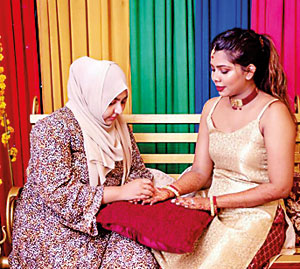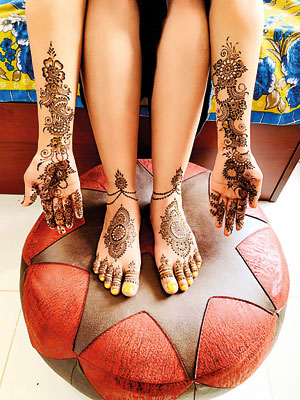Young mums with a passion for spreading beauty of henna

Fazna: Creating a work of art
Henna also known as mehendi is an ancient art. While new trends such as white henna, neon or “glow-in-the-dark” henna have emerged in the West, in Sri Lanka the practice has remained more or less unchanged for centuries.
Though unclear if it originated from India or West Asia, “old” designs from both parts of the world are still seen at special occasions like festivals and weddings.
Founder of Henna Vogue Colombo Fathima Fazna is a busy mother of two, who growing up, spent her free time doodling basic henna designs. Later, she began trying them out on herself, friends and relatives.
“It is the encouragement and compliments I received which made me take this up professionally. Some experienced henna artists gave me the knowledge I needed to improve my skills and I will be forever grateful to them,” Fazna said.
With her children still toddlers, she visits homes and functions and has also had booths at certain trade stalls.
“Earlier henna was either applied as a pulp or paste or with a stick. Nowadays, modern methods are used.”
 Initially only applied to the hands, now designs are done all over the body. Fine-tipped henna cones make it easier to apply intricate designs, Fazna says.
Initially only applied to the hands, now designs are done all over the body. Fine-tipped henna cones make it easier to apply intricate designs, Fazna says.
“Muslim and Hindu weddings are incomplete without henna. Not only brides, but most girls who attend, love henna designs. At the mehendi ceremony, the night before a wedding, the bride applies henna on her hands and feet in preparation for her big day. Henna is also applied for festivals like Diwali, Eid and Hajj.”
Fazna makes her henna paste at home, but when she has no time, she buys a “cone” of henna paste from trusted vendors who make the paste by drying henna leaves and milling them to a powder which is sifted and mixed with water, sugar and essential oils. The paste has a toothpaste-like consistency.
“After application the paste must be allowed to dry completely for 15-20 minutes. The longer the paste dries on the skin, the longer the design remains. The paste tends to crack and fall off during this time, so often it is sealed with a sugar or lemon mix. This also increases the intensity of the shade,” Fazna says.
“When the paste is removed, the design will appear pale or dark orange, and it takes 24-48 hours for the colour to darken to a deep brown.”
“It’s the application method that is time consuming and requires a lot of skill and patience,” she adds.
Some of her clients decide on designs while others give her a free hand. A simple design can be completed in five to ten minutes but the intricate designs applied on brides can take as much as five hours.
Nusrath Najurdeen runs workshops to teach young women henna art. The 23-year-old event planner, wife and mother of a baby girl, henna artist and baker, began her event planning business after completing the International Airline Ticketing Academy (IATA) UFTAA foundation course in Travel and Tourism while teaching at a reputed school.

Nusrath
“I’ve always been passionate about learning something new and teaching others too, and after I left my previous job, I wasn’t sure what I would do next. Then I realised there were others like me who were at home and unable to attend classes due to various reasons and decided to conduct one-day workshops on different topics such as makeup and henna art,” Nusrath said.
Starting the workshops last year, her last workshop was at Cinnamon Grand Colombo when she was seven months pregnant. Nusrath says she wants to encourage all young mums to follow their passions even in challenging situations.
“From a young age I depended on my sister to apply henna on me during Eid festivals. Then I started to learn henna art by myself, watching YouTube videos and practising on a daily basis,” Nusrath said.
Nusrath is hopeful of starting classes again in August.
Contact Fazna through Instagram (henna_vogue_colombo) and Facebook (Henna Vogue) and Nusrath through her Instagram page (shadesofphotographylk).

one of her workshops in progress


